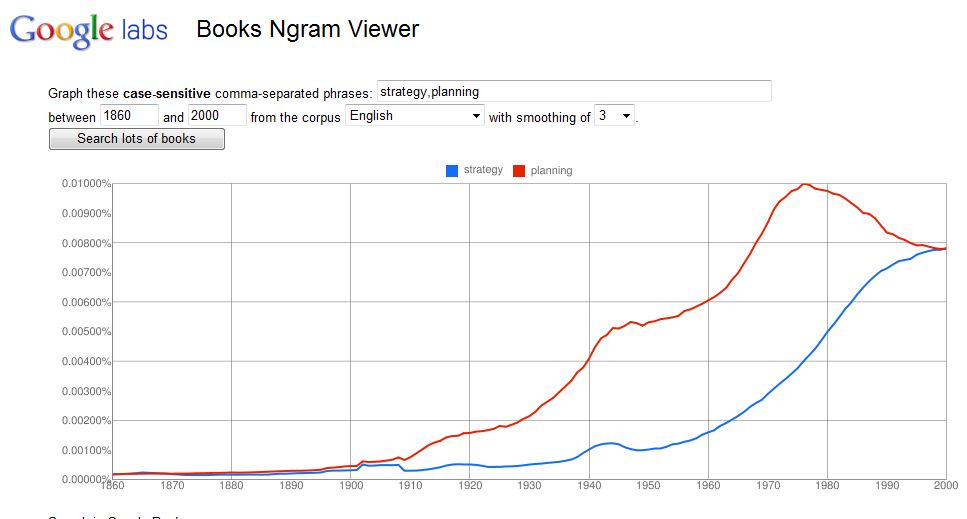The Rise and Fall of Strategy and Planning by Mark Rhodes
Imagine that you could dump all the words of a million books from the past 500 years into a giant database, and look to see how various words have waxed and waned in usage over the centuries. You could look and see when archaic words like thou and yon disappeared from popular usage. You could identify the year the word internet first appeared, and when people started saying garbage instead of rubbish. Oh… You can do that now?! Yes, the Google Monolith has indeed scanned more than a million books into a searchable soup, and we can now play with this facility using something called the Google Books Ngram Viewer. Let’s put the thing to work and examine our favorite topic: Strategic Planning. In the graph below, we can see the degree of usage of the words planning (in red) and strategy (in blue) since 1860.
Strategic planning is an oxymoron. Strategic thinking does not lead to a plan, it leads to a strategy. Rather, planning must follow strategy. If you don’t want to call it operational planning, call it “Planning that Follows Strategy."
Henry Mintzberg, The Rise and Fall of Strategic Planning
Mintzberg argues that organizational strategy is often “emergent.” That is, answers to strategic questions do not arrive like the result at the bottom of a math equation. Rather, strategy emerges and changes as the strategist observes the world and reflects upon the dynamics of the competitive environment.
Of course, there is debate among experts as to what exactly constitutes strategic thinking. Michael Porter, perhaps the most widely cited expert on organizational strategy, says that “strategic thinking rarely occurs spontaneously.” As if to prove his point, Porter provides a dry, methodological approach to the quest for competitive advantage and organizational strategy. Porter provides a set of strategic analysis tools that are serious and rational enough to make any Taylorist or Behaviorist proud. And granted, I have often found Porter’s framework and methodology useful in understanding the competitive dynamics of an industry.
But a quick study of the History of Strategy provides a blinding flash of the obvious: Successful strategy-making is most often an "emergent" process. Employing the emergent approach, the strategist maintains an open mind as to the future direction of the organization, and seizes the moment when opportunity matches organizational capability.
In the end, strategy-making must be thought of as a creative process, as rich in spontaneity and magic as any other art. To apply these notions to our own decision-making , remember that strategic thinking is a yin and yang of left and right brain thinking. To engage in strategic thought, think and reflect on the big picture – the diverse players and forces in your environment. Think about the future. Use your left brain’s capacity to generate rational questions and answers. Use your right brain for intuition and wisdom.
